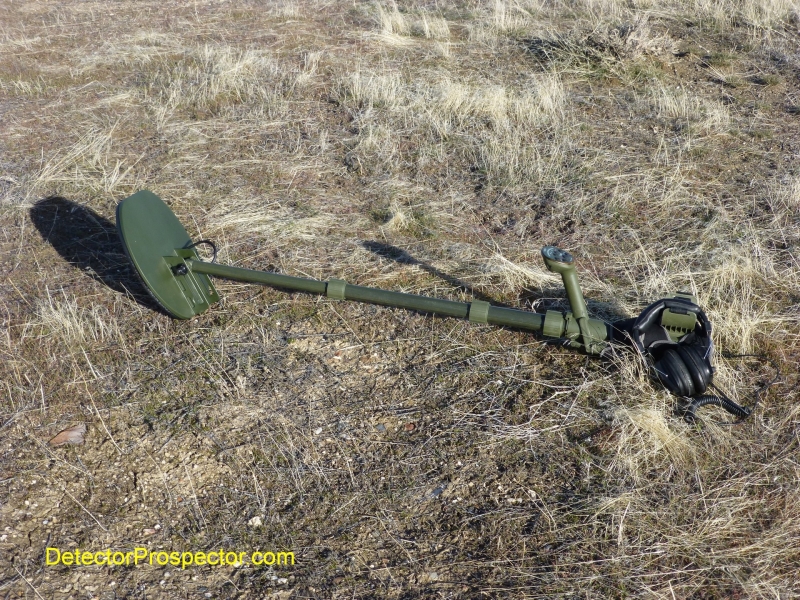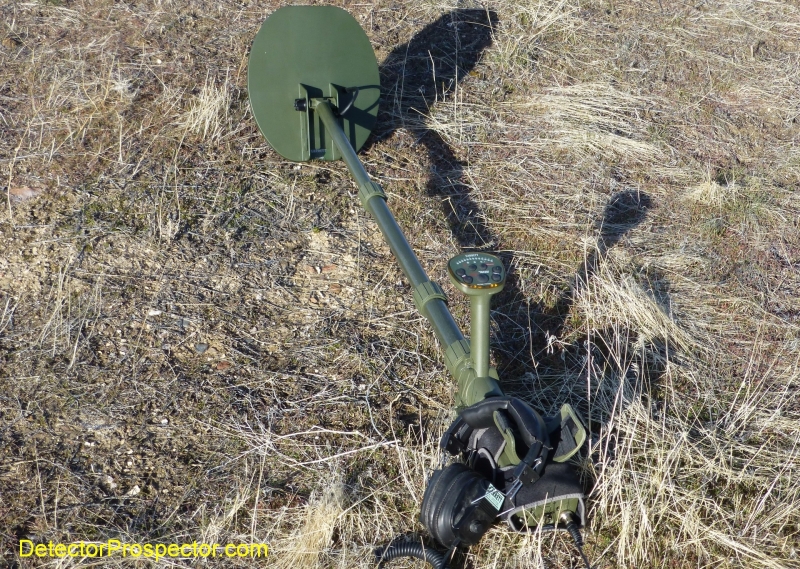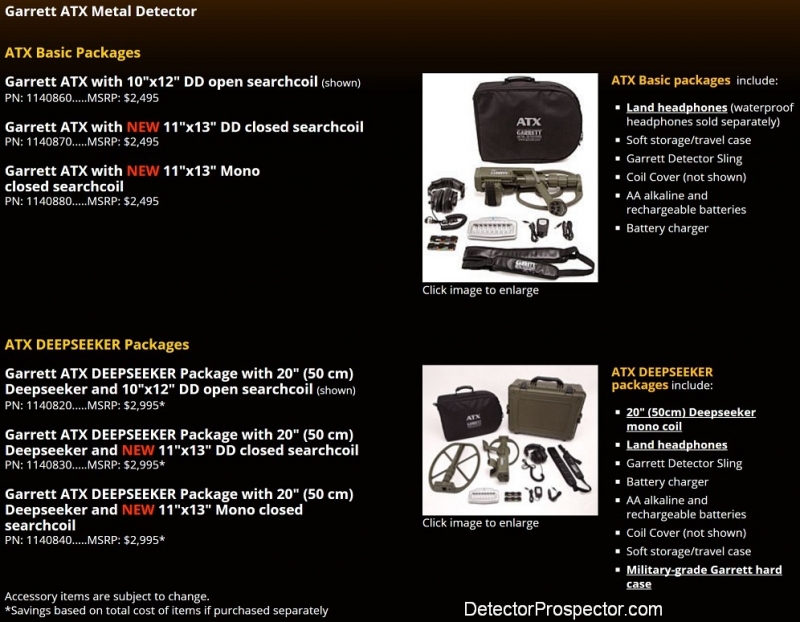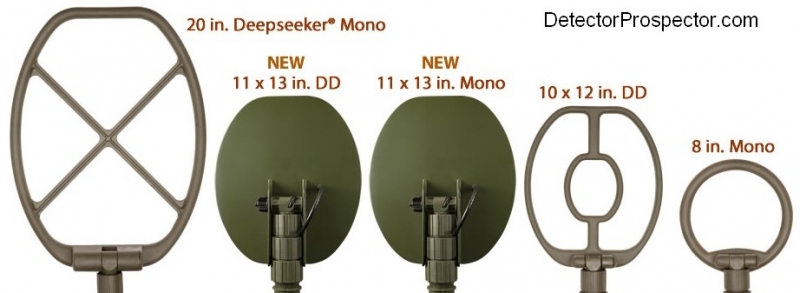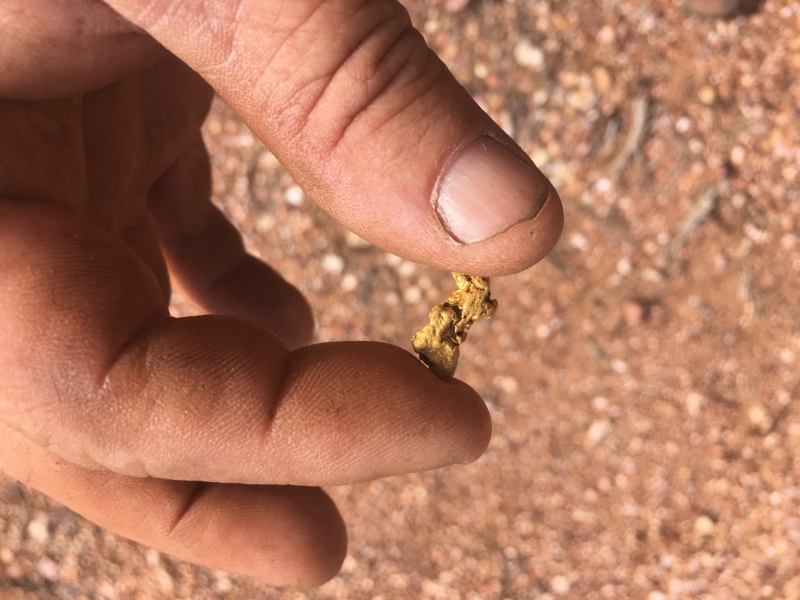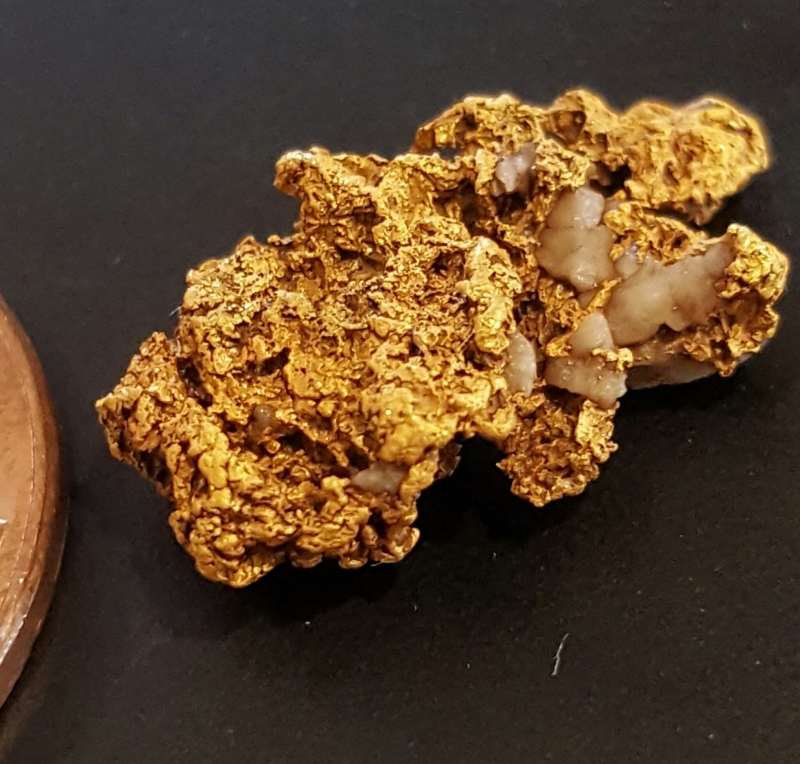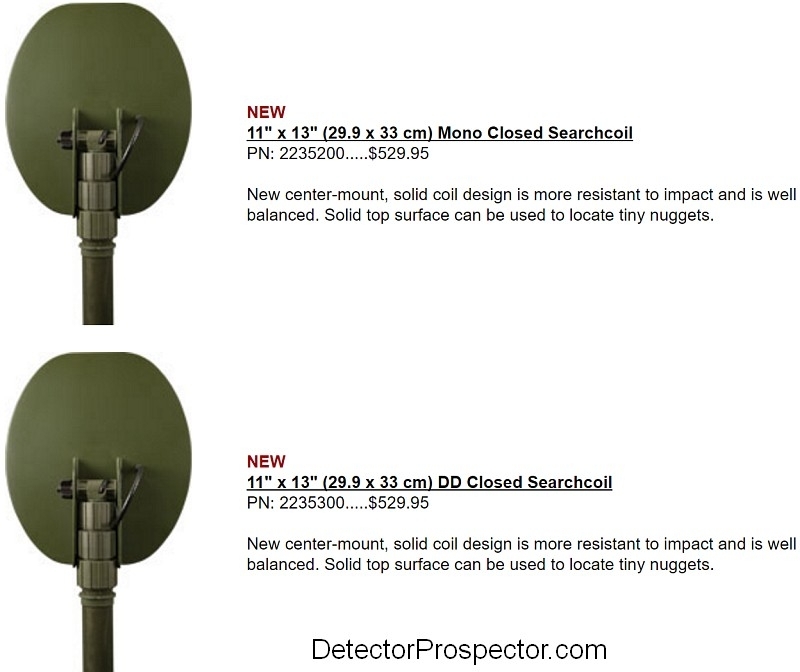Search the Community
Showing results for tags 'garrett atx'.
-
As ATX users know, it uses two sets of 4 AA batteries. Each going into separate compartments. The other day, my detector said it was going dead after several days of use. Before removing the batteries from their holders, I decided to check the voltage. One set was about 2.4 volts and the other was about 4.9 volts! I am using rechargeable which normally charge up to about 5.1 or 5.2 volts per set. So, one set had little use. The detector was operating normal. What feeds on these batteries...... does one set get more use than the other?
-
vanursepaul Posted February 25, 2015 Steve, I would like to see you superimpose the ATX on this bar graph to see where it fits. Paul The whole graph isnt there, but you know what i mean, eh? Steve, remember this one? ...Did you ever do it? Maybe you could have a go at superimposing 2 new columns for each of the 3 nugget pics. (space to the left and right of the GPX and GPZ). Time permitting of course! I'm thinking 1 column representing the old style DEEP SEARCHER 15" x 20" coil, and another for the new flat style, 11" x 13" closed DD coil. If you had space,... stretch it, or create a new chart,... you could even throw in the TDI, and even a Golg Bug for reference/fun. Also assuming similar ground conditions, good or bad. For example:- How close is the 11" x 13" DD coil to the STD coil on the GPX 5000? And whats it like against the SDC2300 on small bits? And is the 15" x 20" coil deeper than the STD GPX 5000? And how far away from the GPZ is it, on big bits? Doesn't have to be an exact scientific test orientated job, more of an approximate one based on your time and experience with this machine. I know its not you No1 gold machine (but is, & could be for others), and you love it for wet beaches, but you won't sell it which says a lot about it... I think. With all the latest new vlf stuff (equinox/gm1000/impact/mx sport/at max) getting all the headlines & peoples attention, does no harm to reflect on something old, something different. After all, YOUR elusive/magic/dry land/sub $2000/lightweight/LTX PI machine hasn't arrived yet! (MINELAB/GARRETT/FISHER/NOKTA/MAKRO/XP??? Wonder who will be first then?)....THAT WILL DEFINATELY GET EVERYONE EXCITETED! I don't think its (ATX) a dead duck. I'm still thinking there's more to it (prospecting) than being relegated to a SUPERB beach PI machine. Just don't bring the weight into it!!! Have you tested the closed DD coil? Improved falsing and balance issues? Thankyou in advance! jim
-
I received the deepseeker coil when I obtained my ATX. I have only been using the stock coil to date, but had a few questions on the larger coil. Since my shaft on the stock coil is partially stuck in the extended position (as much as I have tried to loosen it), and I would like to take the ATX to Houston next week on a business trip (that I hope to find time to do a little Galveston beach hunting... suggestions welcomed)... will the 20" be overkill for my intended hunting? What experiences have you had using the deepseeker coil on the beach? What should I know?
-
I am very new to the ATX, just received mine this past Tuesday, but have been out for a few hours each day since, including a couple attepts at a local lake/swimming home. My hunting at this point is mainly geared toward jewelry and coins (prospecting at some point.. but that is another forum). My question is about the iron grunt feature... will a non-iron target give an iron response depending on depth or mineralization surrounding the target? Especially in the lake, where I have to trust the feel of my foot and scoop in murky water... I have experienced several hard hitting targets (both low-high and high-low tones) giving the iron grunt. Am I making a mistake by passing up those targets? Thanks, Tim
-
Doing research on my atx I'm so glad I found this site. Atx is driving me bonkers in the salt water on the gulf coast florida panama city beach to be exact and my trips to south beach. Problem I'm having is trying to run with factory settings with sens 13 , what happens is a lot of drift which is fine I can hear targets thru drift but then atx screams like it is locked on to a target and stays that way with the yellow dots fixed on the far right screen which doesn't allow me to hit targets even my scoop. I then retune and after a few swings same thing again. If I ground balance sens 13 I can run fairly smooth with some drift however only targets I'm digging are shallow. I watched a video on ground balancing on detectors comparisons on u tube with the infinium and atx side by side on wet sand both were hitting targets deep , then atx was ground balanced and lost a dime at 10 inches which it picked up easily in factory mode with sens at 13. So it looks like if ground balancing is used depth is really reduced ? Another test they did was run sens at 10 in factory sens and still couldn't pick up dime at 10 inches. Not sure what I'm doing wrong really would appreciate any tips as losing faith in atx. By the way my duelfield runs smooth in the drink , thinging its much less sensitive than the atx ? My detector is ctx which runs smooth. I bought the atx to use in sanded in conditions but not working for me so far. thanks jimmymac
-
Firstly, thanks for sharing your stories and knowledge here. I can't tell you how grateful I am for the lessons that you have saved me from having to experience for myself. I would be very grateful if some of the ATX users would share some of their Saltwater / Beach set-up preferences and experiences. I am pretty new to the Hobby and I am having a little difficulty trying to work out the best way to set up my ATX for use in saltwater. I live in T&C and the water here is VERY saline as we don't have any rivers. While Steve H has some good info from his ATX in Hawaii, our beaches are more Parrot fish by-product than volcanic sand. Any feedback would be very helpful and much appreciated.
-
Going to pick up a garrett atx for nugget detecting which of the packages would you recommend? Have VLF gold detectors but want to venture into pulse now and seems to be the ATX would be a great start.
-
Garrett is really disappointing us, I bought an atx when they were released in 2013 Nov, their stock coil had a lot of issues, they never cared. Just imagine 2013!!!! They replied n 2017, with their 2 new expensive coils, (price of an AT gold detector), well currently I was hoping that they will do test and tell us the differences amongst these 3 coils, but they don't bother!!!! Up to now in their Web site there is nothing on performance of their new coils. it seems they are concentrating on vlf detectors and for us, we just took a risk buy buying their PI detector - oh poor zimbabwean I thought Americans were far better than the Australians, now I am stating to doubt, maybe I should have gone minelab, should I buy another coil for atx??? (or it will b another piece of lemon AGAIN) or just sell my atx and get a minelab?????
-
I am unfortunately time limited right now, with family stuff occupying quite a bit of time the next couple weeks. However, Garrett was kind enough to rush me a couple of the new 11" x 13" coils to check out and I wanted to give at least a preliminary report on the mono version at this time. The new coils are aimed at a couple issues that owners of previous ATX coils have complained about. First, the rather unique rear hinge design of the stock ATX coils that allows the detector to fold up into a particularly compact configuration. This design has two issues. As the coils age the forward weight tends to cause the coil to slowly sag forward. Not a huge factor but it can result in constant small adjustments to level the coil out. More important it throws the weight of the coil forward, hurting the center of balance. Again, not a huge issue, but one that becomes more apparent if you try and mow through high grass and weeds with the ATX. Garrett came up with an ingenious fix for this issue, that both allows the coil to fold up as desired while delivering that center mount coil so many have craved. The new coil design has a sliding channel that lets you move the coil attachment point from rear to center or anywhere in between. You don't see something really new in metal detecting very often but this really is. And it works. Here is a shot of the new coil with the old design inset into the upper right (Click on all photos for large version). The old stock coil is an epoxy filled 10" x 12" DD design that together with the attached rod assembly weighs 3 lbs 7 oz. The new 11" x 13" mono weighs in at 3 lbs 7.5 oz, again with the attached rod assembly. Basically a wash, although the new coil is slightly larger in overall dimensions. Electronically however it is a much larger coil. A mono coil normally will get better depth than the same size DD coil although in the worst ground DD coils have an edge. DD coils also offer a form of iron discrimination on the ATX that will not work on a mono coil. The ATX seems to be optimized for DD coils and for most gold prospecting the DD coil is probably the better option. For sheer depth on the largest nuggets however mono is often the way to go, and in this case the coil itself is not only a mono but also slightly larger than the stock coil. That is why this coil got my attention first over the 11" x 13" DD version. I made a quick run out to the northern Nevada goldfields. The weather has finally let up but everything is still real wet out east of Reno. I mean real wet - stick to the bottom of your boots mud kind of wet in places. That oddly helped a bit in this case as the ATX is a PI that can easily handle wet salt ground, and in fact it is my favorite salt water detector. The ground balance range runs well into the salt range so I don't think there is any wet salt ground it can't handle. I should point out however that ground balancing out salt does also balance out small gold signals that read identical to the salt signals. This is one of those unsolvable issues with the way current metal detectors work. But better to tune out the worst of the salt in some places and take what gold can be found still. Listening to constant salt signals masks gold also, so there is no perfect solution. In any case, the ATX did prove its capability on this little test run as the ground is both wet and salty where I was, and the ATX 11" x 13" mono ground balanced to it with ease, even with the sensitivity cranked all the way up to the highest setting. Unfortunately I found no gold this day although I did recover some ridiculously small ferrous targets plus some bullets. I did learn a few things to report though. First, the new center mount coils really do balance better and push through grass and weeds much better than the older rear hinge design. The second thing however is more important. One thing I mention in my earliest ATX reports is that "The stock coil is marginally sensitive to false signals when contacting rocks. This is a bit odd since it is an epoxy filled coil so in theory the coil windings cannot move to produce false signals when bumped. The signals do not occur consistently or often but in my case at least happened most often when the coil would catch a rock on the surface and roll the rock under the coil. It is possible that the coil cable, even though protected by being enclosed in the lower shaft assembly, is jiggling enough to produce the signals." I never determined exactly what the cause of these false signals were, but others also reported them. They typically occurred only at higher sensitivity settings and could be tamed with careful coil control, but they were an annoyance. The good news is the new coil design appears to have alleviated this problem. I won't go so far as to say completely eliminated yet, as more hours are needed and more reports from other people under other circumstances, but I did not experience any falsing caused by bumping this coil against rocks or other objects. I was getting some faint signals from running a mono coil at max gain riding directly on salt and mineral ground, but that is because I was in all truth running the sensitivity higher than I perhaps should, a habit of mine. I tend to push my detectors hard. The 11" x 13" mono shares a common mono trait by being hottest around the outside edges. Very small surface targets will tend to signal twice, once for each time an edge passes over the target. This can be handy for knowing you are dealing with tiny surface items before digging a deep hole chasing one. There is also a tendency for the signal to sharpen at the four "corners" of the blunt end coil design. Small targets can be pinpointed by turning the coil on edge and running one of these corners around in the dirt as a sort of pinpointer. When using a plastic scoop to isolate small targets, use those corners as your hot spots. As I noted earlier I am tied up with family business for a while, but I will be reporting more on this and the DD version in the future. These new coils will have me breaking the ATX out for more prospecting this summer than has been my norm in the past. I have tried the 15" x 20" mono coil for the ATX, and frankly this new mono coil in my opinion is a far better option for prospectors. The rear mounted open 20" length of the larger coil made it difficult to handle in the grassy sagebrush areas I frequent. More importantly, I found that although the 15" x 20" coil does offer more depth on very large targets the gains on normal size nuggets were minimal if any and the smaller stuff can't be detected at all. My honest opinion the main benefits with the 15" x 20" are found both in ground coverage and on very large targets but the lack of sensitivity to smaller gold nuggets is a concern. The 11" x 13" mono is a much better size that in my opinion will offer better depth on the larger nuggets prospectors are likely to find than the 15" x 20" mono coil. However, do not think the 11" x 13" is going to be some kind of huge improvement in depth over the stock coil on large nuggets. People always seem to overestimate the advantages of larger coils. That extra inch? Yes. Twice the depth or even 50% more depth? No, don't set yourself up for those kinds of expectations, they are not realistic. If I was buying a new Garrett ATX today for gold prospecting, I would be looking hard at these two new coils because the ATX can now come equipped with one of them as the stock coil. The new knock resistant fully enclosed coil design that is also less likely to hang up on sticks and obstructions. The center mount design handles far better. I don't see how any avid ATX user could be unhappy with this new coil design. The DD coil is still probably the better option for most people with the mono more for those chasing the largest nuggets at depth.
-
Hi there, is there anyone who have used the 11x13" garrett mono coil so far?how is it,compared to the stock coil??in terms of depth,and mineralization handling??
-
Thinking about getting a new PI detector. I have had a Minelab GP3000 and Whites TDI. I really liked the GP3000 for the depth, but I quickly found out the area I hunt had too much EMI and the gold tends to be more porous and sometimes "sugary like", and the GP 3000 just couldn't see the gold. So I have pretty much just been using a Gold Bug II. Would really like a GPZ 7000 but don't think it will be possible. So I was looking at the Garrett ATX or Minelab SDC 2300. Reading reviews on the ATX it seems quite a few people complain about coil falsing when hitting objects with the coil. Does anyone know if this has ever been fixed by Garrett? Or have the new coils fixed it? Would the ATX detect this porous gold? It's been a long time since I bought a new detector and I haven't really kept up with any of it. Thanks.
-
The new 11" x 13" mono and DD closed coil options have now been incorporated into new detector packages for 2017. This means you can get your choice of one of several stock coil options when buying a new ATX. I would like to see more of this from manufacturers so good for Garrett! Prices below are manufacturer suggested retail price (MSRP) so figure 15% off for internet pricing. More details at the Garrett website.
-
Well, it looks like Garrett finally has the New ATX coils added to their web site! http://www.garrett.com/hobbysite/hbby_atx_searchcoils_en.aspx Beav
-
I know this is an apples to oranges comparison and don't intend to determine which is "better" as each is better suited for certain specific tasks. That being said, I do want to find out which machine would do better (deeper) on tiny small gold. I suspect the AT Gold would be stronger on less than 0.2 gram nuggets but I know the ATX is quite good on small nuggets also (better than the Infinium). I've recently watched a couple of videos where the AT Gold hit a one grain nugget at about an inch and the ATX found a 0.16 gram nugget near the surface in bedrock (thanks Bearkat4160 and DetectorComparisons). So, has anyone compared these two machines on tiny nuggets? I'd appreciate any info.
-
Hi, new here , I would like to know if anybody has any idea of when the new!! Coils are coming out for the atx , l need one and don't want to buy one and then have new one available. I have had a good run with this detector using it for nugget hunting. regards, Squizz
-
I always like when people post their recent finds, it motivates me to go out and find my own. Had some time to do a short hunt this am near Johnnie NV. Walking a small drainage with the 8 inch coil on my ATX I find this 1.7 g specimen about 4 inches down, not even on bedrock. It was underneath a shoe sized rock. Clear strong signal. Detected the majority of the wash for nothing else. I am notorious for finding single nugget washes lol. Was still happy to find this, lots of character. Chris Closup
-
I did a bit of Google searching for posts in the last year to see if I could get a feel for how much use the Garrett ATX gets and what people are finding with it. Not much to see though. The Garrett Australia Facebook page has some gold nugget finds https://www.facebook.com/GarrettAustralia/ The Findmall ATX Forum would have you thinking the ATX is strictly a beach detector Link deleted since Findmall Forum update broke all old links and other than that a few relic hunters out there using it. The ATX is one of my favorite detectors and quite a capable nugget detector, but after some early nugget detecting it now only gets used seriously as a beach and water detector. The problem is with ATX at $2120 and 6.9 lbs, limited coil selection, it is a tough machine to recommend for prospecting with a Minelab GPX 4500 running only $2699 at this time. I still consider the ATX to have been a missed opportunity. At $1699 in a lighter weight dry land package and sporting less expensive dry land coils the machine could have made a real impact on the prospecting world. Instead it is a rare sight on the goldfields.
-
A new member just made his first post yesterday on Prospecting Australia, You gotta gotta see it,, Bugga Me. Make sure you are sitting down with no sharp objects within your reach. john https://www.prospectingaustralia.com.au/forum/viewtopic.php?id=6453&p=107
-
Hi all, New to the Forum and have a problem I hope someone can help me with. Well I think the ATX (used) I recently got is down for the count After the initial park test where the machine worked as advertised I took it to the lake for a water hunt. It was running real quiet and smooth at the first two beaches. Scored a silver ring and St Christopher medal on a chain Good frequency scan and GB. At the third beach I got a low batt indicator and did a battery change back at the truck. Upon returning to the water the machine was acting real erratic with lots of false signals and LED indicators flashing up to the 7/8 range and even locking at this level. I thought well maybe its EMI or drift so I checked with my buddy who is running an infinium and he said his machine was purring like a kitten. So I did another factory reset and decide to run in ground tracking. I was still getting signals but hard to hear the faint ones with all the falsing. I checked the battery compartment when I got home and no leaks. Batteries were in proper polarization and no reversed cells. So I decided to take it to the park today where I originally tested it with a fresh set of batteries. Did Freq Scan and GB. The GB seemed a little off from when I first got the machine. That is when I press the button and get the two tones I'm not hearing much ground signal. I noticed this at the lake also. Anyway tried to run and with the coil stationary I'm getting a pulsing signal from 1-4 LED range and spiking up to 7/8 range. The signal then locked at 8 and wouldn't go away without a reset but then continued the pulsing. So I decided to do a factory reset and that's when it got interesting. Usually on a factory reset I get two tones followed by the 4 battery check tones. The machine went straight to 4 tones with no LED display. So the machine is on and making spurious noises but no LED's are on. Did this a few times with the same results. So I put the machine away and got my GP3000 out as a control test. The 3000 noise canceled and GB'd in this park fine and I dug a few signals till the rain started. Anyway this kind of rules out that there was some type of crazy EMI that can't be eliminated. Next I called the local dealer who sold the machine to the guy I bought it from and he thought it might be the coil. back at the house I slid the shaft out a bit and had a look at the coil wire connector. Put in a new set of batts and checked the coil connector for leaks saw none but where the wire goes into the black connector there is some type of rubbery gasket material that is squeezed out a bit. Any way I fired up the machine and it went through a normal cycle with LED's and did the frequency scan but still getting that spiking signal. I can turn sens down and bring that signal down but then cant hear test targets through the signal at the low sens level. Dealer told me to call Garrett on Monday and that is the plan. I think there is still 6 months on the Warranty but well see. Anyone have similar problems? I have this message posted on the ATX forum and a member there suggested testing my machine with a known good coil. Anyone in the Reno area with an ATX and a good coil that I could use as a test on my machine? I know that's a lot to ask but and maybe not even a good idea. Maybe Steve will know?
-
What is the opinion out there on using the ground tracking function on the ATX in highly mineralized ground. What is the trade-off by using this function in regards to depth?
-
I was detecting over the weekend with my Garrett ATX near Redding. The ground was moist and was mostly a reddish-orange clay like soil from the decomposed shale bedrock I am assuming. When I moved away from the creek bottom (gravels and bedrock) and went up on the hillside or in tributary gulches I would encounter soil areas that made the detector constantly give a target signal or what I would say is a mineralized ground wine or squeal. I tried ground balancing several times, but it did not alleviate the problem. Ended up shutting down the machine and relocating, basically starting over in a new area where I could maintain a normal threshold sound. I have used the machine for about a year and this has happened a couple times, but it happens infrequently. The first time it happened I had a low battery and figured it may have been a symptom of a low battery. Any ideas, similar experiences, and/or tips using the ATX would be appreciated. Thanks in advance.
-
Garrett is releasing two new, larger 11”x13” closed searchcoils for the ATX pulse induction detector. Available in either a DD or mono configuration, the new ATX coils will be lighter weight and offer increased depth versus the standard ATX searchcoil. The new closed style provides more resistance to falsing due to scrubbing of the coil against the ground and allows gold prospectors to use the upper coil deck to sift/find tiny nuggets easier. The new ATX searchcoil includes an exclusive Garrett design slide-lock system that creates a center-mount style while still allowing the ATX to collapse into its soft cover carrying case. Designated for a mid-year release, the new ATX coil will be available as the new standard offering on ATX detectors and can be purchased as an accessory coil by existing ATX customers. More details and pricing on the new ATX packages will be forthcoming. http://www.garrett.com/hobbysite/pdfs/Garrett_New_Products_2016.pdf
-
Hello, Need some help/advice. I receive a Garrett ATX from my kids for Christmas. I am new to metal detecting, but the kids wanted to buy me a real good detector for beach hunting. I live in Rhode Island and plan on doing a lot of beach hunting. I also live in a very historic (colonial) area of the U.S and would like to do some relic/coin hunting. I know this is an advanced PI machine and I am a beginner, but I now own this machine and have to learn how to use it. I know there are other machines that would be better for relic/coin hunting, that will discriminate out most of the iron, I have done a lot of internet research on this topic. The kids bought me this machine, not going to return it, so I need to learn how to use it. The last two days I ventured out into some local fields to try out my new machine. These fields are surrounded by 200+ year old stone walls (very common in New England). This area was settled by the early colonist, so there is a lot of stuff (junk and potential good targets) in the ground. This area, I'm sure, has been hunted for decades by metal deterorists, so if there is anything else to find, I will assume it is deep. From the research I have done, the Garrett ATX would be a machine to go down deep. Well, the last two day were interesting/frustrating. I am a very patient person, and yes, I know it will take a long time to really understand how to use this machine and learn all the tones and sounds. I dug up a lot of iron the last two days, sometimes the iron check works, and other times it doesn't. I am hearing mostly high/low signals and only a few low/high signals. The pin pointing works real well. So any advice to help me learn how to use this machine the correct way, or is it really just lots of time in the field? Any advice/help would be greatly appreciated.




